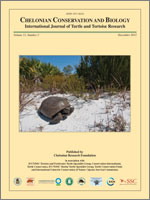The Sonoyta mud turtle (Kinosternon sonoriense longifemorale) is a member of the unique desert riparian fauna isolated along the Rio Sonoyta watershed in northern Sonora, Mexico, and southern Arizona. This subspecies occupies six sites along the Rio Sonoyta, a pool at Quitovac in Sonora, and one pond at Quitobaquito Springs in Organ Pipe Cactus National Monument in Arizona. Since the mid-1980s, population estimates for the US population have ranged from 39–153 individuals. In 2006–2007, the human-made Quitobaquito Pond began losing water, and discussions were held concerning the fate of the turtles. During three salvage efforts all Sonoyta mud turtles encountered were captured and transported to temporary holding facilities. Because the minimum number of turtles needed for re-establishment was unknown, we conducted a Population Viability Analysis (PVA) to determine the number of Sonoyta mud turtles that should be held in an assurance colony. Results from both our PVA and previous work suggested that juvenile survivorship has the strongest effect on female transition rates from nonreproductive to reproductive age classes and in turn population growth; thus, a wide range of age classes should be maintained in an assurance colony.
How to translate text using browser tools
1 December 2012
Conservation Status of an Endemic Kinosternid, Kinosternon sonoriense longifemorale, in Arizona
J. Daren Riedle,
Philip C. Rosen,
Richard T. Kazmaier,
Peter Holm,
Cristina A. Jones
ACCESS THE FULL ARTICLE
Arizona
assurance colonies
Kinosternon sonoriense longifemorale
population viability analysis
Reptilia
Sonoyta mud turtle
Testudines





